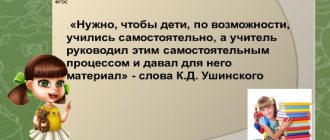Intellectual game “What? Where? When?”, topic: “Economy”
A game for a preparatory group in economics in the style of what? Where? When? Where both adults and children ask questions. Through this game, children consolidate their knowledge of economics and learn to independently discuss and find the correct answer. Goal: To consolidate knowledge of economics.
Program content:
- learn to answer in complete sentences;
- consolidate knowledge about economics using complex words (barter, auction);
- develop the ability to negotiate with each other and independence.
Preliminary work: Presentation “The History of Money”; D/games: “Income-expenses”, “Auction”, “Profession-salary”; Role-playing games: “Bank”, “Cafe”, “Supermarket”, etc.; Mathematical game "Calculation for travel."
Material: Video questions from teachers, parents, children; money in envelopes with numbers, a spinning top, a round table, a black box, music for a musical break, a treble clef, lots (quilling cards), a drum with a hammer.
Progress of the lesson
Educator: Guys, today I suggest you play the intellectual game “What? Where? When?”, where you can earn money with your knowledge. All this earned money will be useful to you for the further game: “Auction”. Today you are not just children, but experts in economics.
Then the team captain spins the top every round, choosing a question number; after four questions, a musical pause is set.
Questions for the game recorded on video:
- Now I want to travel around Europe, but each country has its own banknotes. Dear experts, please advise which currency is best for me to take with me. (Dollar, Euro)
- People organize auctions where they sell jewelry, paintings and antiques, starting with a minimum price, which increases several times. Attention, question: What are these auctions called? (Auction)
- What is the name of the money that goes into the family budget and vice versa? (Income Expenses)
- What is the best way to save money for the benefit of the family and why?
- Since ancient times, people have exchanged goods for goods, for example: salt for matches, sugar for bread, etc., as it is called in our time (Barter).
- I'm going to school soon, I ask my parents to buy me a warm fur coat, when is the best time to buy it?
- I went to St. Petersburg today, my mother gave me 5 thousand rubles for pocket money, I left 1 thousand for a water park, 2 thousand spent on gifts, 1 thousand on entertainment, and on the way back we stopped in Moscow. Attention, question: How much money did I spend in Moscow if I saved and brought home 1 thousand rubles? (0)
- Black Box: You have to guess what is in the box. Previously, it was furs, fabrics, rice and other valuable items of the country, then it began to be called hryvnia, and now this is what lies in the black box. (Money)
During the game, the children consult with each other, finding the correct answer, then the team captain chooses who will answer, who answered this question there and gets an envelope with money containing different amounts. All envelopes are numbered.
Educator: Now you need to open the envelopes and count who has how much money.
Then the teacher offers to play an auction game, where quilling, burning, and embroidery crafts made by children’s hands are offered.
Self-analysis of the intellectual game in economics: “What? Where? When?".
The purpose of the lesson was to consolidate knowledge of economics, new words and concepts that were covered in previous classes and games. The main task of this game is unity and the ability to negotiate.
The children liked the game, the questions that were asked by people they knew from the video, and not by the teacher himself, they were very intrigued and interested, and the children consulted with each other with interest, having found the correct answer. The children opened up well during the game and showed everything they are capable of: the ability to discuss, answer in full, negotiate, and count.
During the game, the children all worked actively and were all involved. I myself am pleased that I played this game, because I was worried that the children would argue about who would answer, but they listened to every opinion. The result of the game satisfied me in that the preliminary work went well, the children coped with the most difficult questions.
I think the lesson went well, the goal was achieved, I can give myself and my children an excellent rating.
Now I use this game for other areas of knowledge.
During the auction, the children showed different sides of themselves: some saved money, others spent everything at once. But I can say with confidence that now they will play this game on their own and will be even more happy to make crafts with their own hands.
Integrated game with parents “What? Where? When?" in the preparatory group of the preschool educational institution
- September 9, 2016
Competition “Methodological piggy bank of a teacher - 2016”
Nomination “Methodological piggy bank of a preschool teacher”
A joint game-activity with parents and children of the preparatory speech therapy group “My City Naberezhnye Chelny” develops children’s communication abilities and the ability to communicate with parents and peers in the classroom. During the game, children consolidate knowledge about their hometown.
Topic: “My favorite city Naberezhnye Chelny”
Goal: to continue to form elementary ideas of pupils about their small Motherland - the city of Naberezhnye Chelny.
Tasks:
Correctional and educational:
- Activate and expand children's vocabulary on the topic “My City” with definitions, adjectives, verbs.
- Practice transforming nouns with diminutive suffixes and plural nouns.
- Exercise in the formation of prefixed verbs (arrive, leave, drive in, drive away).
- Strengthen the skills of composing sentences with the preposition above.
- Strengthen the skills of composing simple and complex sentences.
Correctional and developmental:
- Develop verbal communication skills, develop the ability to read poetry expressively.
- Correct logical thinking, creative and compositional abilities, imagination of students;
- Improve coordination of speech with movement, smoothness and strength of voice.
Correctional and educational:
- To foster patriotic feelings and love for the Motherland.
- Systematize the idea that for every person, a small Motherland is the place where he was born, where he spent his childhood;
- Continue to introduce the sights of the city of Naberezhnye Chelny.
Integration of educational areas: Cognition, communication, socialization, reading fiction, artistic creativity.
Materials and equipment: Computer, presentation “My City”, Whatman paper with an image of a city landscape, badges - emblems for teams: “Kamazyata” and “Pochemuchki”; prizes; two envelopes, cut-out pictures of the coat of arms of the city of Naberezhnye Chelny.
Preliminary work:
• Conversations: “Me and my family”, “My city”. • Examination of illustrations about the city of Naberezhnye Chelny, maps of the city of Naberezhnye Chelny, examination of the state symbols of the coat of arms of the city of Naberezhnye Chelny. • Reading and learning poems about the city, listening and learning songs about our city in recordings. • Drawings by children on the theme: “My city.” • Production of attributes.
Progress of the game
– Dear children and parents, we invite you today to test your knowledge about our beloved city Naberezhnye Chelny.
Watch a video clip about the city of Naberezhnye Chelny.
Speech therapist:
Oh, Chelny! I write these lines with love! My city is my life and destiny. White stone and tall. Strict lines and simplicity. My grandfather built houses and factories, erected buildings and workshops. He left me a city as a legacy, a city of happiness, a city of dreams.
Speech therapist: Now let's start the game. The rules of the game are as follows: the presenter reads out the question, the teams listen carefully, then a minute is given for discussion, after which the team captain, having introduced himself, gives an answer or introduces a team member who will answer the question.
The questions are divided into sectors, where a hand is drawn, you can ask for help from your parents, a bell is a physical exercise; Smart owl - questions for parents.
- The blue sector is historical.
- The yellow sector is the coat of arms and flag.
- Green sector - culture
- Orange sector – interesting tasks.
The jury decides whether the answer is correct or false. The score is announced after each question. The group is divided into two teams “Kamazyata” and “Pochemuchki”. Team mottos:
Team "Kamazyata"
We are “Kamazyat” guys, we love to run and jump, and answer questions!
Team "Why"
“We are inquisitive minds, We have questions for you. “Why” is a favorite question, Helps us grow!
– I ask the teams to take their places. For each correct answer, the team will receive a token.
I round “Historical sector”
- What is the name of our country? Name the capital of Russia?
- What is the name of our republic?
- Name the capital?
- What do the words “small homeland” mean?
- What is the name of our city?
- What are the people of our city called?
- Near which Russian river is the city of Naberezhnye Chelny located?
- Why do you think it is called that?
– There is a main version of such a name that in Bulgarian the word CHAL meant STONE, and in Turkic CHALLY – STONE FORTRESS. In the name, the word chelny represents a boat, and the definition embankment indicates the location of a hill on the shore. Our city with you is the city of Naberezhnye Chelny, which we are proud of today.
2nd round “Coat of arms and flag”
Music is playing, children are spinning the top.
– A black box was sent to us for the game. From the parts, the teams need to lay out the coat of arms of Tatarstan and the coat of arms of Naberezhnye Chelny. Parents will help the teams.
– The leopard has long been the coat of arms of Volga Bulgaria, whose successor is Tataria. The winged leopard of Tatarstan also symbolizes sublimity and wisdom. On the side of the leopard there is an eight-petalled aster; the meaning of this flower is a wish for longevity. The raised paw of the leopard, according to the authors of the composition, means the divine nature of power, and the teeth and claws of the leopard mean the opportunity to defend independence.
The main figure of the flag, the shuttle, indicates the name of the city, making the composition a vowel. The boat is a symbol of tireless movement forward, overcoming obstacles, taming the elements and a means to achieve a goal. The nose decoration in the form of a maiden head shows the image of a woman as a symbol of the hearth.
A full sail speaks of a fair wind, good luck and success in all endeavors. The sail of the boat, in its outline, resembles a stylized image of a tulip - a traditional symbol of spirituality, emphasizes and enhances the significance of the city, showing Naberezhnye Chelny as a unique pearl of Tatarstan.
Oars lowered into the water indicate that the residents of Naberezhnye Chelny use not only natural forces to move forward, but also apply their efforts.
III round “Who is attentive”
Questions about the city like the game “Fourth Wheel”.
1. What building is not in the city of Naberezhnye Chelny? (Ice palace, water park, theater, train station).
2. What kind of passenger transport is not available in our city? (Bus, trolleybus, tram, taxi).
3. Which tree fills our city with “snow” in the spring? (Birch, poplar, maple, rowan).
4. What is the name of the building where city chess tournaments are held? (Sports Palace, library, chess and checkers club).
5.What is the name of the car that the Automobile Plant produces? (GAZ, VAZ, KAMAZ).
IV round “Choose a definition”
Team “Kamazyat” to select and read as many definitions as possible for the word KAMAZ - powerful, huge, large, iron, heavy, etc.
Team “Pochemuchki” to choose definitions for the word Naberezhnye Chelny – which ones? Beautiful, spacious, young, modern, large.
Physical education minute “We walk around the city, drive, fly, call”
- We walk around the city, we name what we see (selection of buildings, Olympic swimming pool, Victory Park, organ hall...). Why do we call too much? What do we call one by one?
- We quickly got on the bus and went around the city (naming avenues and transport with prefix verbs: we will arrive, we will arrive, we will depart, we will leave)
- The plane is calling us on our way, we will go on a flight (selection of sentences with the preposition over-).
V round “Question for Mom and Dad”
What was the name of the first settlement on the site of our city?
- Careful boats
- Good boats
- Polite boats.
What was on the base of the Tarlovsky sanatorium during the war?
- Military hospital
- Military unit
- Military plant.
When was the first stone laid for the construction of the Kama Automobile Plant?
- 1969
- 1959
- 1979
Explain what the female head on the coat of arms of our city means?
- Family traditions
- Striving forward
- Sports traditions.
What famous people have monuments in our city?
- Pushkin
- Yesenin
- Vysotsky.
What is the name of the largest church in Naberezhnye Chelny?
- Borovetskaya
- Cosmas and Domiana
- Pokrovskaya.
The team that glorified our city, republic and country throughout the world.
- "Kamaz-Master"
- "Kamaz-Batyr"
- "Kamaz-Class".
Round VI “Let's talk about the wonderful city, whose name is Chelny”
Child:
I want to glorify the White City on the Kama, the Fatherland, which taught me to know, Every day I value Chelny more and more, And I want to tell the whole country about them.
- There is a city on the Kama River………
- In Naberezhnye Chelny they are wide…….green…….high…….
- Our city is young, ………
- There are many monuments in our city…………
- We have a lot of ..... sports in our city.
- My mother and I go to the puppet theater and ...... hall.
- The plant produces a heavy-duty vehicle…….
- In summer we like to walk in the park……………, there are a lot of……….
- My dad and I go to….., to root for the team…….
- Every year in the summer we go to ………….., there are many beautiful buildings there.
- I love our city because………
Invite each team to choose one pair of players and mothers to jointly compose a story according to the proposed scheme.
Lesson summary:
- What new did you learn about yourself today?
- Which task was the most interesting?
- Which player on your team deserves to be called the best today?
Summing up, awarding the winners.
Author: teacher-speech therapist of the 1st qualification category Tatyana Valerievna Zaloiko, KMBDOU No. 52 “Fairy Tale”, Naberezhnye Chelny.
Presentation for class
Quiz about cartoons for 5 years old
With the help of a quiz it is easy to check how well children know the plot of cartoons and what they pay attention to. In addition to the proposed questions, children can be read a description of the cartoon - and they must say its name themselves or choose from interesting options.
- What cartoon was Princess Jasmine in? (Aladdin)
- How many robbers have stood up to Alibaba? (40)
- What was the name of the hippopotamus from the cartoon Madagascar? (Gloria)
- The big green character who lived in the swamp is... (Shrek)
- Who is always in a hurry to help? (Chip and Dale)
- How many nephews did Scrooge McDuck have? (Three)
- What was the name of the disgruntled octopus, SpongeBob's acquaintance? (Squidward)
- In which cartoon do puppies come to the rescue? (PAW Patrol)
- How many Dalmatians were there in the popular cartoon? (101)
- What was the name of Cheburashka's best friend? (Crocodile Gena)
- The name of the horse from the cartoon about 3 heroes... (Juliy)
- Who can move around the city on a web? (Spiderman)
- What was the name of the moose from Smeshariki? (Losyash)
- What is the name of the cartoon where a squirrel tried to get a nut out of ice? (Glacial period)
- What was the name of the big black cat from the cartoon about Mowgli? (Bagheera)
Riddles for the development of thinking of 5-6 year olds
The purpose of riddles is not just to formulate questions on a certain topic, but also to have fun. We have selected the top 15 interesting tasks for kids that can test their general knowledge.
- Jumps through the trees and hides nuts. (Squirrel)
- A faithful friend for a person, will become a running companion. (Dog)
- A fluffy ball, a ball of wool. Drinks milk and purrs easily. (Cat)
- The nose is a snout and the tail is a hook. (Pig)
- Butts and jumps, hides a lot of fur. (Goat)
- I am stubborn, small, related to any horse. (Donkey)
- It takes five hours for me to crawl a step. (Turtle)
- Throw in meat, onions, potatoes. Eat the pan, not the spoon. (Soup)
- Striped, scarlet, everyone loves me very much. (Watermelon)
- Not an easy neighbor, but a real mother hen. (Chicken)
- A beep will notify everyone when there is boiling water. (Kettle)
- A stick with a thread and a hook, with it you will be a fisherman. (Fishing rod)
- It drives and buzzes, in a hurry to take everyone home. (Car)
- Let's go on a trip and put at least a bear there. Small and large, they store expensive things. (Suitcases)
- We put the earhooks on the small ears. (Glasses)




